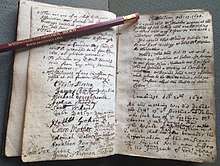Cambridge Association
The Cambridge Association of Boston, Massachusetts, was the first formal association of Congregational ministers in America.[1] It began when influential Boston area clergymen regularly met in the Harvard College library between 1690 and 1697.[2] The minutes of their meetings shed important light on the oft-debated question of the extent to which the ministers supported the use of spectral evidence in witchcraft trials. Cotton Mather began the group in 1690 with a letter to Samuel Parris the minister in Salem village. Increase Mather's important essay Cases of Conscience was first presented to this group at a meeting on October 3, 1692.
Between 1700 and 1745, the original association was divided into the "Associated Ministers of Boston and Charlestown" and the "Association in and about Cambridge." In 1960, these two groups reunited as the Greater Boston Association of Unitarian Ministers.[3]
Membership

The record-book suggests Charles Morton and Cotton Mather were two important founding members of the group. Together with the bylaws, the two men's names give the appearance of sharing the same ink, and at the first (or second) organizational pre-meeting, on October 13, 1690, Cotton Mather is listed as the one who will tell Harvard that the group will have their first official meeting in the library a week later, on October 20. Charles Morton was the most senior and placed his name at the top and Cotton Mather signed lower, perhaps leaving space in between for other designated members to sign in order of seniority, including James Allen (Boston First Church), Michael Wigglesworth (HU 1651), Joshua Moodey (H.U. 1653), Samuel Willard (HU 1659, Boston South Church), John Bailey, and Nathaniel Gookin (HU 1675, d. Aug 15, 1692). Four of these men -- Morton, Allen, Moodey, and Willard-- had also signed an introduction to Cotton Mather's book Memorable Providences the year before in 1689.
Increase Mather did not return from London until May, 1692, and likely signed the book, next to James Allen's name, soon after his return and he is first listed as definitely present on June 27, 1692. Nehemiah Walter (HU 1684) was Increase Mather's son-in-law and doesn't seem to have been present until around the time Increase Mather joined. Jonathan Pierpont (HU 1685) is also first noted as present on August 1, 1692.
Others joined later, sometimes years later, and they seem to have eventually begun to sign the designated page of the book in a jumbled order, where space permitted, including: Jabez Fox and John Fox, James Sherman, Benjamin Woodbridge, Benjamin Wadsworth (H.U. 1690 and future President), Benjamin Colman (HU 1692), William Brattle (HU 1680), Ebenezer Pemberton (HU 1691), Samuel Angier (HU 1673), John Fox, Henry Gibbs, and Thomas Bridge. Although some these men worked at Harvard as tutors, fellows, and library-keepers, and thus may have been present in some capacity at meetings in the library, it is unlikely any joined officially before being ordained as a minister.
Arrangements & By-laws
The group met mid-morning on Mondays “...once in six weeks, or oftener if need shall be.” At the end of each meeting the date of the next was chosen. A moderator was also chosen to keep the minutes at the next meeting and he also chose the next question for the group to ponder and discuss.
"Our work at the said meetings shall be 1) to debate any matter relating to ourselves. 2) To hear and consider any cases which shall be proposed to us from any other associations or private persons. 3) To answer any letters directed to us from any other associations or persons. 4) To discourse of any question proposed at the former meeting.
Provenance of the Record Book
The Massachusetts Historical Society acquired the record book in 1850[4] and have traced it back to original member Charles Morton who had also taken part in similar group in England called the Cornwall Association 1655-1659. The records of the Cornwall association immediately precede those of the Cambridge Association. The Rules and Regulations are similar for both associations and are believed to be in Morton's handwriting. Morton likely brought the book over to New England around the time of the Restoration when Nonconformist ministers were suppressed and many emigrated.
References
- ↑ Walker, Williston (1894). A History of the Congregational Churches in the United States. American Church History. 3. New York: The Christian Literature Company. pp. 198–199.
- ↑ Proceedings of the Massachusetts Historical Society vol. 17, 1879. Public Domain.
- ↑
- "Boston Association of Ministers. Records, 1755-1960: A Finding Aid". oasis.lib.harvard.edu. Retrieved June 11, 2017.
- ↑ Proceedings of the MHS vol 2, 1850. Public Domain.
- Proceedings of Massachusetts Historical Society vol 17, published 1879, public domain